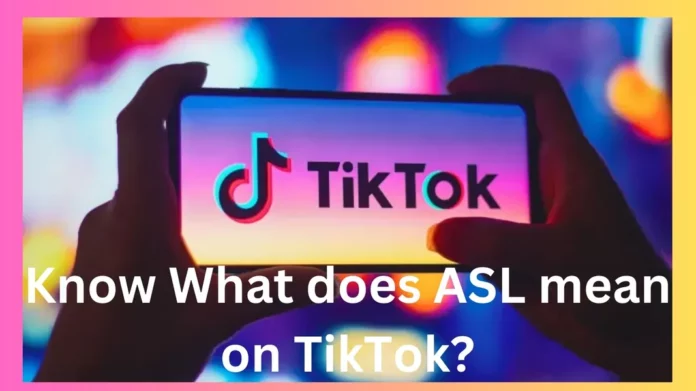TikTok, the popular social media platform known for its short-form video content, has become a hub for creativity, self-expression, and entertainment.
Users from around the world flock to TikTok to share their talents, stories, and interests in various forms, making it a versatile platform for content creators and consumers alike.
Among the many trends and subcultures that have emerged on TikTok, one of the most fascinating and impactful is the use of American Sign Language, often abbreviated as ASL.
ASL on TikTok is more than just a form of communication; it’s an art form, a means of expression, and a way to build a sense of community within the platform. In this feature, we will explore what ASL means on TikTok, its significance, its evolution as a form of entertainment, and the impact it has had on both the Deaf and hearing communities.
Chapter 1: What Does ASL Mean on TikTok?
ASL, or American Sign Language, is a visual and gestural language used primarily by the Deaf and hard-of-hearing communities in the United States and parts of Canada. Unlike spoken languages, ASL relies on handshapes, facial expressions, and body movements to convey meaning. On TikTok, ASL has taken on a unique role, transcending its traditional use as a means of communication.
1.1 ASL as an Art Form
TikTok has given rise to a new form of artistic expression through ASL. Creators on the platform have harnessed the visual and kinetic elements of sign language to create captivating and emotive videos. Whether it’s a powerful story told entirely in sign language, a dance choreographed to ASL interpretations, or a heartfelt message delivered through expressive facial expressions, TikTok has allowed ASL to shine as an art form.
One of the most well-known ASL creators on TikTok, @the.deaf.artist, uses the platform to share beautiful and intricate ASL poetry. Through her videos, she weaves together words and signs to convey deep emotions, often accompanied by poignant visuals. Her content resonates not only with the Deaf community but also with hearing audiences who appreciate the artistry and creativity of ASL.
1.2 Building an Inclusive Community
TikTok’s algorithmic approach to content discovery has made it possible for creators using ASL to connect with a global audience. ASL creators often use hashtags such as #DeafTikTok or #ASL to categorize their content, making it easier for like-minded individuals to find and engage with their videos. This has led to the creation of a supportive and inclusive community where Deaf, hard-of-hearing, and hearing users can come together to appreciate and learn from one another.
ASL challenges on TikTok have become a popular way for creators to showcase their skills while educating others about Deaf culture and the beauty of ASL. These challenges often involve teaching a specific sign or phrase, allowing hearing users to learn and engage with the language. In turn, this promotes cultural awareness and breaks down communication barriers between the Deaf and hearing communities.
Chapter 2: The Evolution of ASL on TikTok
The presence and influence of ASL on TikTok have evolved significantly since its inception. Initially, TikTok was primarily a platform for sharing lip-sync videos and short skits, but as it gained popularity, it became a space for diverse forms of creative expression, including ASL.
2.1 Early Adoption and Advocacy
Deaf TikTok creators were among the early adopters of the platform, recognizing its potential for spreading awareness about ASL and Deaf culture. They used TikTok as a platform to advocate for the importance of accessible content and representation for the Deaf community.
Creators like @thatdeafgirljess, who has a substantial following on TikTok, used the platform to raise awareness about issues affecting the Deaf community, such as the need for closed captions and sign language interpreters in various media. Her advocacy efforts, combined with her engaging content, played a crucial role in fostering the growth of ASL on TikTok.
2.2 Mainstream Recognition
As ASL content gained traction on TikTok, it started to receive attention from mainstream media and entertainment industries. Some ASL creators have been featured in television shows, commercials, and even music videos, further expanding the reach and impact of ASL as an art form.
One notable example is the inclusion of ASL interpreter Brittany Broski in the music video for Meghan Trainor’s song “Holidays.” This move was widely praised for its inclusivity and recognition of ASL as an integral part of the music video’s storytelling. Such instances have contributed to breaking down barriers and promoting the use of ASL in mainstream media.
Chapter 3: The Impact of ASL on TikTok
The impact of ASL on TikTok is multifaceted, affecting both the Deaf and hearing communities in profound ways.
3.1 Empowering the Deaf Community
For Deaf and hard-of-hearing individuals, TikTok has provided a platform where they can showcase their talents, share their stories, and advocate for their rights. ASL creators on TikTok have become role models and sources of inspiration for many in the Deaf community, proving that they can succeed and thrive in the digital age.
The platform has also given Deaf creators a voice in shaping how their culture and language are perceived by a wider audience. They can correct misconceptions, educate others, and foster a greater understanding of the unique experiences and challenges faced by Deaf individuals.
3.2 Promoting Accessibility and Inclusivity
TikTok’s embrace of ASL content has prompted discussions about the importance of accessibility in digital media. Many hearing TikTok users have become more aware of the need for closed captions and sign language interpreters in various online and offline settings. This heightened awareness has led to increased advocacy for making content accessible to all, including those with disabilities.
3.3 Fostering Cross-Cultural Connections
ASL on TikTok has served as a bridge between the Deaf and hearing communities. Through shared challenges, collaborations, and educational content, TikTok has facilitated cross-cultural connections and friendships. Hearing users who have learned ASL through TikTok often express their appreciation for the language and the Deaf community, fostering a sense of unity and understanding.
Chapter 4: Challenges and Considerations
While ASL on TikTok has brought about numerous positive changes, it is not without its challenges and considerations.
4.1 Appropriation vs. Appreciation
One concern that has arisen is the fine line between appreciating ASL as an art form and appropriating Deaf culture. Some creators on TikTok may unintentionally or intentionally exploit ASL for views and likes without respecting its cultural significance. It’s important for TikTok users, both Deaf and hearing, to approach ASL content with cultural sensitivity and awareness.
4.2 Ensuring Accessibility
Despite the platform’s growing inclusivity, TikTok still faces challenges in ensuring full accessibility for Deaf and hard-of-hearing users. While creators may include closed captions, not all content is accessible, and the platform could do more to prioritize accessibility features. Additionally, improvements in AI-driven sign language recognition and translation tools could enhance the experience for ASL users on TikTok.
4.3 Representation and Diversity
While ASL content has made strides in representation, there is still room for growth in terms of diversity within the Deaf community. TikTok has the potential to amplify underrepresented voices and experiences within the Deaf and signing community, and creators should continue to strive for inclusivity.
Chapter 5: The Future of ASL on TikTok
The future of ASL on TikTok is promising, with opportunities for further growth and impact.
5.1 Continued Advocacy
TikTok creators who use ASL will likely continue to advocate for greater accessibility and representation. As their reach expands, they can influence how the platform develops its accessibility features and policies, making it a more inclusive space for everyone.
5.2 Educational Initiatives
TikTok’s potential as an educational tool for ASL learners is vast. Creators who teach ASL have the opportunity to reach a global audience, fostering a greater understanding of the language and culture. Educational institutions may also recognize the value of TikTok as a supplementary tool for ASL learners.
5.3 Collaboration and Innovation
As TikTok evolves, creators may find new and innovative ways to incorporate ASL into their content. Collaborations between ASL creators and mainstream celebrities could become more common, further bridging the gap between Deaf and hearing communities. Additionally, advances in technology may lead to more sophisticated ASL recognition and translation tools on the platform.
Conclusion
ASL on TikTok represents a remarkable convergence of entertainment, education, advocacy, and cultural exchange. What began as a means of communication for the Deaf community has transformed into a powerful form of artistic expression and a platform for fostering understanding and inclusivity. The impact of ASL on TikTok reaches far beyond the screen, contributing to a more accessible and culturally aware digital landscape.
As ASL continues to evolve on TikTok, it is essential for creators and users to approach this medium with respect, empathy, and a commitment to inclusivity. The future holds exciting possibilities for ASL content on TikTok, and its influence is likely to shape the platform and its users for years to come.















